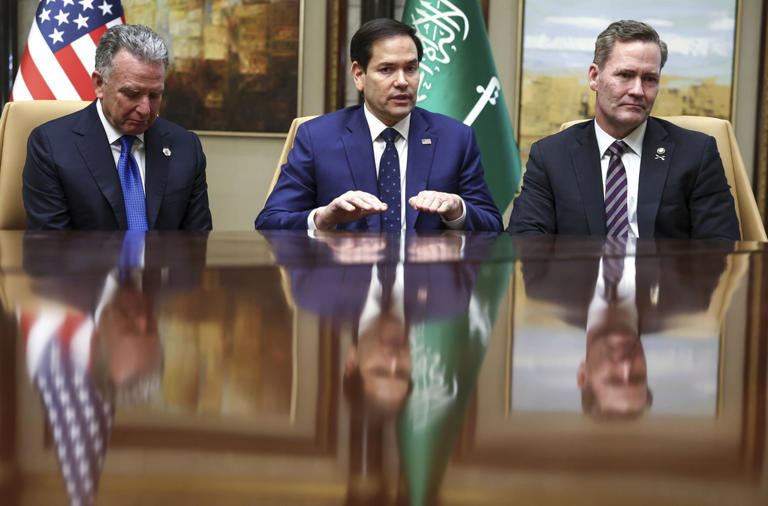US-Russia Talks: What Really Happened & What’s Next?
Top U.S. and Russian officials held their most extensive talks since Moscow’s invasion of Ukraine nearly three years ago, meeting for almost four hours Tuesday in Saudi Arabia. The discussions, led by U.S. Secretary of State Marco Rubio and Russian Foreign Minister Sergey Lavrov, marked a significant step toward mending ties, with both sides calling the meeting productive.
They agreed to establish teams to restore staffing at their embassies in Washington and Moscow, aiming to use these diplomatic channels to support Ukraine peace efforts and explore economic cooperation, including potential joint energy ventures. However, this renewed engagement could strain U.S. relations with Europe and weaken Washington’s influence in NATO and Ukraine.
Under former President Joe Biden, the U.S. and Europe prioritized isolating Russia and upholding the post-World War II international order. Now, this shift in diplomacy signals a potential recalibration of global alliances.
Rebuilding U.S.-Russia Diplomacy: A Key First Step
One of the first major achievements from the high-level U.S.-Russia talks was an agreement to restore long-strained diplomatic ties, which hit a post-Cold War low after President Vladimir Putin’s 2022 invasion of Ukraine.
The meeting, held just a week after former President Donald Trump’s phone call with Putin, marked the most substantial face-to-face engagement between the nations’ top diplomats since former Secretary of State Antony Blinken met with Russian Foreign Minister Sergey Lavrov in early 2022 in a failed attempt to prevent the war. Following Tuesday’s talks, Lavrov announced plans to expedite the appointment of new ambassadors and hold further meetings to address “lifting artificial barriers” that have hindered embassy operations.
However, the deterioration of diplomatic relations between the two countries began long before 2022. The first major rift followed Russia’s 2014 annexation of Crimea, leading to U.S.-ordered closures of Russian offices. Tensions escalated further in 2018 after the poisoning of an exiled Russian spy and his daughter in Britain, an attack Western nations blamed on Moscow. This resulted in mass expulsions of diplomats and consulate closures across the U.S., Russia, and Europe.
When asked if the U.S. now considered these past incidents resolved, Secretary of State Marco Rubio avoided specifics but emphasized that diplomatic engagement was essential for any Ukraine peace deal. “We can’t end the conflict without at least some normalcy in how our diplomatic missions operate in Moscow and Washington,” he said.
Negotiating an End to the Ukraine Conflict
The U.S. and Russia agreed to establish high-level working groups to explore a negotiated resolution to the Ukraine war, though the timeline for their first meeting remains unclear. Both sides signaled urgency in moving discussions forward.
Trump’s national security adviser, Mike Waltz, confirmed that key topics would include territorial concessions and security guarantees. Secretary of State Marco Rubio added that a team of experts will engage with Russia to define the “parameters of what an end to this conflict would look like.”
However, Russia made it clear that it would reject any NATO troops as peacekeepers in Ukraine. Foreign Minister Sergey Lavrov reiterated Moscow’s stance that Ukraine’s NATO ambitions pose a direct security threat, warning that NATO-member forces—regardless of their banner—would be “unacceptable.”
Excluding Ukraine and Europe from Talks
Notably, neither Ukraine nor European nations were invited to Tuesday’s meeting in Riyadh. While U.S. officials denied any intention to exclude them from future negotiations, Ukraine’s absence fueled criticism.
“No one is being sidelined,” Rubio insisted, emphasizing that consultation with Ukraine and European allies would follow. Waltz echoed this sentiment, stating, “If you’re going to bring both sides together, you have to talk to both sides.”
Despite these reassurances, Ukrainian President Volodymyr Zelenskyy was visibly frustrated, canceling a planned visit to Saudi Arabia to avoid any association with the talks.
The exclusion of Ukraine also drew sharp criticism from Western analysts. Nigel Gould-Davies of the International Institute for Strategic Studies argued that the negotiations appear skewed in Russia’s favor, questioning whether they represent genuine diplomacy or “a series of American capitulations.”
Trump, however, dismissed Ukraine’s objections. Speaking from his Florida residence, he suggested that Ukraine should have conceded to Russia before the invasion began. “You should have ended it three years ago,” he said. “You should have never started it. You could have made a deal.”
Possible Lifting of U.S. Sanctions on Russia
When asked about lifting sanctions imposed during the Biden administration, Rubio acknowledged that concessions would be necessary on all sides but declined to speculate on specifics. On whether the U.S. would remove Lavrov from its sanctions list, he stated, “We’re just not at that level of conversation yet.”
Potential U.S.-Russia Cooperation
Kirill Dmitriev, head of the Russian Direct Investment Fund and part of the Russian delegation, suggested that the U.S. and Russia should explore joint energy ventures, including projects in the Arctic.
Rubio indicated that resolving the Ukraine conflict could unlock “incredible opportunities” for U.S.-Russia collaboration, though he stopped short of detailing what that might entail.




l4a8ae